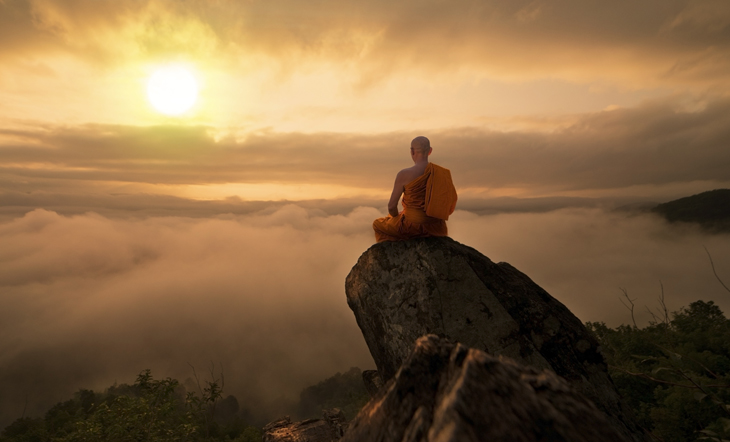Finding Presence
A teaching and practice on the Four Yogas of Dzogchen Semde. The post Finding Presence appeared first on Tricycle: The Buddhist Review.

Spontaneous presence (lhundrup in Tibetan) is the natural, effortless manifestation of awareness in every moment. It is also the culmination of the Four Yogas of Dzogchen Semde. The four yogas are:
Tranquillity (népa) Stillness (migyowa) Nonduality (nyamnyi) Presence (lhundrup)The Semde tradition is the oldest form of Dzogchen, originating in Oddiyana (Northern Pakistan) around 665 CE. The Semde teachings emerge when tantric practice is dominant in the Buddhist world and mark a clear departure. They are a return to the teachings found in the Early Sutras, especially the Anguttara Nikaya (AN 1.49-52), which includes this statement:
Luminous, mendicants, is the mind. And it is defiled by incoming defilements.
Luminous, mendicants, is the mind. And it is freed from incoming defilements.
This sutra speaks to the intrinsic luminosity and purity of the mind, which is only temporarily obscured or “defiled” by adventitious afflictions (defilements) but can also be freed from them. The luminous nature of the mind aligns closely with the Dzogchen Semde teachings on the mind’s inherent purity, despite the defilements that temporarily seem to obscure it.
The Semde tradition is unique among Dzogchen teachings in that it is not secret or restricted, though it does require a foundation of ethics, meditation experience, and a qualified guide. It cannot be learned from books, only through directed experience under the tutelage of a teacher. It is not secret or restricted because it is not tantric and does not have the same dangers associated with tantric practice. In fact, the core texts of the Semde tradition reject all aspects of tantric practice. As Samantabhadra, the primordial Buddha who is the source of Dzogchen, instructs in this excerpt from the seminal Semde text the Kunjed Gyalpo:
Do not practice in the worldly way by meditating on the form of a deity as the activity
of the body, by reciting mantras and formulae as the activity of the voice, or by
visualizing and concentrating as the activity of the mind.
The Four Yogas of Dzogchen Semde are a sequence of meditations that lead directly to realization of our natural condition (Dzogpachenpo) and the true nature of mind (rigpa). The final yoga results in Spontaneous Presence, which is like a mirror that reflects whatever appears before it without effort, bias, or delay. The mirror does not have to decide to reflect an image; it simply does so, spontaneously and perfectly. Similarly, spontaneous presence means that the pure awareness of rigpa is always present, manifesting naturally without any need for cultivation or fabrication. It is the innate wisdom and clarity of the mind, arising in the present moment without any interference or modification. It simply needs to be revealed.
The mirror does not have to decide to reflect an image; it simply does so, spontaneously and perfectly. Similarly, spontaneous presence means that the pure awareness of rigpa is always present, manifesting naturally without any need for cultivation or fabrication.
Achieving or revealing spontaneous presence is not about striving or effort but about relaxing deeply into the natural state of mind. It’s like a river flowing effortlessly down a mountain—there’s no force or control, just a natural movement in harmony with gravity. When we stop trying to control or manipulate our thoughts and experiences, we allow awareness to flow naturally. By simply resting in the present moment, without grasping or pushing away, we recognize that this spontaneous presence is always there, like the river’s flow.
Spontaneous presence is also like the sun shining in the sky. The sun does not need to “try” to shine; it simply radiates light by its very nature. In the same way, our true nature is already luminous and clear, spontaneously present at all times. When we stop covering it with the clouds of conceptual thinking and effortful practice, the light of awareness shines spontaneously. Achieving spontaneous presence is not about adding something new but about recognizing and resting in the innate clarity and awareness that is already there, ever-present, like the sun behind the clouds.
How do we find or reveal presence? This is easy. It takes just three steps. We achieve spontaneous presence by first committing to live ethically according to the five Buddhist precepts, then by taming the mind through meditation and awakening joy and devotion. Then, when we are ready, we let go of all effort, trusting in the natural state, and recognizing that everything—thoughts, emotions, and perceptions—arises spontaneously within the vast expanse of awareness. There’s no need to control or create; we simply rest in the open, uncontrived nature of mind, where everything manifests with perfect spontaneity.
A Practice: Meditating to Find Presence
How do we meditate to find presence? Meditation is just sitting. That’s it. Meditation is nothing more than sitting calmly and quietly and allowing whatever happens to happen. Everyone can sit still, calmly and quietly, so everyone can meditate.
To begin, sit in a comfortable posture with your spine straight, either on a cushion or a chair. Gently rest your hands on your knees or in your lap. Let your eyes remain open, with your gaze slightly lowered. If you need to, you can sit with eyes softly closed. Bring your awareness to your breath, to the experience of breathing in the whole body. There’s no need to control the breath—just gently observe it as it is.
Allow thoughts and emotions to arise without resistance, like clouds passing through a clear sky. Instead of engaging with them, simply let them dissolve on their own. Whatever comes, let it come and then let it go again. The most important thing is to meditate a little bit each day. In our tradition, we sit for short periods multiple times a day.
As your awareness grows ever more lucid over time, rest in the stillness that lies beneath the surface of thoughts. If your mind wanders, gently bring it back to the breath, but without force. Over time, this practice reveals the spacious, clear nature of your mind, allowing you to simply be, without striving or attachment.
If we meditate in this way we will naturally progress through the four Semde yogas and eventually abide in spontaneous presence. If we wish to boost the process, we need to awaken the heart. The heart is opened through either devotion to our teachers or through the power of the Four Immeasurables: Joy, Love, Compassion, and Equanimity.
In our tradition, we begin by awakening joy. Joy is not something external that we must seek or acquire, but an intrinsic quality of our own awareness. It arises naturally when we rest in our true nature, which is pure, uncontrived, and luminous. Like sunlight reflecting off water, joy sparkles effortlessly within the vast expanse of awareness, free from any grasping or striving. This joy is not tied to circumstances or fleeting pleasures; it is the radiant expression of rigpa, our natural state of clear and knowing awareness.
Joy is an inherent quality of the mind, much like the luminous clarity of awareness itself. When we relax into this open, boundless state, free of conceptual thinking and attachment, joy arises spontaneously. It is the glow of recognition, the gentle delight of being at ease with reality as it is. At first, we need to use a form of meditation practice to give rise to joy. In time, we will be able to abide in the joy that is the inherent quality of our mind. At that point the other Immeasurables will emerge naturally. First love, then compassion, then equanimity. They emerge naturally because they are the radiance of our true nature, our buddhanature.
Just as the Four Immeasurables emerge naturally through our practice, so too the Four Yogas of Tranquility, Stillness, Nonduality, and Presence emerge naturally through our consistent meditation. In the Semde tradition, we do not need any practice other than simple meditation supported by the vast view of Dzogchen–the primordial purity of mind and all things. Everything is pure, luminous, and non-dual. Everything we experience, our thoughts, feelings, perceptions, and the external world, is an expression of primordial purity and spontaneous presence.
This is a very simple path, unrestricted and open to all. It is a pure and perfect gift from the Buddha to each and every being capable of sitting calmly and quietly and allowing whatever happens to happen, which is absolutely everyone, including you.
This article is an adaptation of sections of Pema Düddul’s latest book, Natural Presence: Concise Advice on Buddhist Practice.

 UsenB
UsenB 































